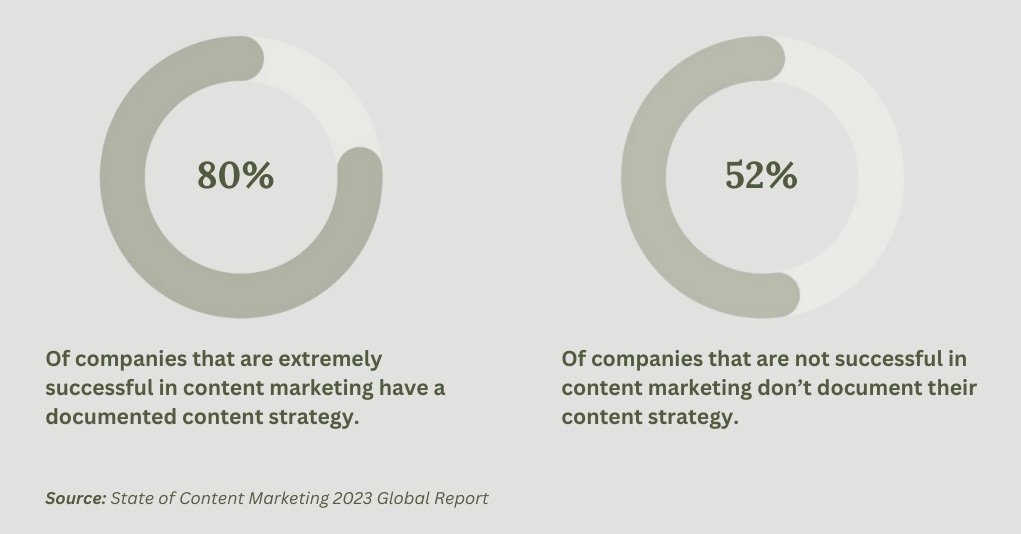Whether you’re just dipping your toes into the digital marketing pool or you’re already making waves, taking a fresh look at your digital content strategy is always a smart move.
In today’s hyper-competitive online landscape, having a rock-solid content marketing strategy is absolutely crucial. Your competitors are constantly upping their game, and to stand out, you’ve got to keep pace. That’s where a killer digital content strategy comes in.
By honing in on your objectives, gaining insights into how your audience interacts with online content, and devising a strategic plan, you’ll be primed to capture your audience’s attention amidst the digital noise.
Ready to dive in? This comprehensive guide has got you covered, from soup to nuts, on crafting a digital content strategy that’s sure to make waves.
What is a Digital Content Strategy?
So, let’s talk about what digital content strategy entails. Essentially, it’s like your business’s roadmap for creating, sharing, and managing all the stuff you put out online. We’re talking blog posts, photos, videos, podcasts—anything your audience can soak up on the web.
Now, why do the big players swear by these strategies? Well, it’s all about tailoring every piece of content to fit into your customer’s journey, from the moment they first stumble upon your brand to long after they’ve hit that ‘buy’ button.
Here’s a breakdown of what a digital content strategy usually involves:
Audience Research: This is where you get cozy with your target audience, really understanding what makes them tick, what keeps them up at night, and how they navigate the online world.
Content Creation: You gotta whip up content that’s not just good, but great. It’s gotta be top-notch and speak directly to your business goals.
Distribution: You need to figure out where your content’s gonna live online—whether it’s on social media, your website, or maybe even a podcast platform.
Optimization: Of course, you can’t forget about optimization. You want your content to be like a magnet for search engines and users alike, so it’s all about fine-tuning with techniques like SEO and user testing.
Content Analysis: Last but not least, you’ve gotta keep an eye on how your content’s performing—tracking things like traffic, engagement, and conversions. Then, you use all that juicy data to tweak your strategy and keep those results coming in even stronger.
Why Your Business Needs a Digital Content Strategy in 2024
Trust me, it’s not just about posting stuff online randomly; it’s about making a real impact and standing out in the digital crowd. In fact, a staggering 80% of marketers achieving remarkable success in content marketing have a meticulously documented strategy in place.

Here’s how having a solid digital content strategy can really make a difference for your business:
First off, it’s all about attracting customers: In today’s digital landscape, your audience expects more than just a website or social media presence. They want valuable, engaging content, and they’re more likely to stick around and become loyal customers when they find it. A well-crafted digital content strategy ensures you’re consistently delivering content that resonates with your target audience, drawing them in and keeping them coming back for more.
Then, there’s the competitive edge: Let’s face it: the internet is a crowded place. Every second, people are bombarded with content from countless brands vying for their attention. To stand out, you need a strategy that sets you apart from the competition. By identifying gaps in your competitors’ content and seizing opportunities to differentiate yourself, a smart digital content strategy gives you that edge you need to stay ahead.
Not to mention, it’s a real time-saver: Without a clear strategy in place, you risk wasting precious time and resources creating content that misses the mark. A well-thought-out strategy helps you focus on the types of content that will yield the best results for your business, maximizing your efficiency and ensuring you’re getting the most out of your resources.
Lastly, a good digital content strategy keeps your content aligned with your business objectives: Your content shouldn’t just be random pieces floating around the internet; it should serve a purpose and contribute to your overall goals. By setting clear targets and KPIs, your strategy helps you track the effectiveness of your content and ensures it’s always working towards driving business growth. So, whether you’re aiming to increase sales, boost brand awareness, or foster customer loyalty, a well-executed digital content strategy is key to making it happen.
Crafting an Effective Digital Content Strategy For Your Business
Let’s dive into crafting a solid digital content strategy that truly resonates with your audience.
Step 01: Conducting a Content Audit
Start by conducting a thorough content audit across all your platforms – your website, social media channels, and any other places you publish content. This will give you valuable insights into what’s working and what’s not.
Pay attention to what content resonates with your audience and what falls flat. Keep an eye out for outdated or irrelevant content, which could potentially confuse your audience.
Zoom out for a broader perspective. Are you overloading certain topics or neglecting others? Could your content be underperforming due to lack of keyword optimization?
Identifying these gaps in your digital content strategy allows you to refine your approach and better align with your objectives.
Step 02: Defining Your Goals and Objectives
Before you start churning out content left and right, take a moment to pinpoint your goals and objectives. What’s the end game here?
Consider your endgame. Are you looking to boost brand awareness, snag more leads, or ramp up sales? Whatever your target, make sure your goals are crystal clear and quantifiable. Rather than a vague aim to “increase blog traffic,” aim for something concrete like “boost website traffic by 35% over the next 4 months.” This specificity helps you stay on track and measure your progress effectively.
Also, think about how you want your brand to come across online. What’s your brand’s tone and core values? What story do you want your content to tell? By nailing down your brand identity, you ensure consistency and authenticity across all your online platforms. So, take the time to define what your brand stands for and how you want it to be perceived in the digital world.
Step 03: Determine Your Target Audience
When diving into your digital content strategy, understanding your target audience is key.
Start by reviewing your audit findings; they’ll give you insights into who’s interacting with your content. Utilize tools like Google Trends or Facebook Audience Insights for deeper dives into demographics and online behaviors. Once you’ve outlined your audience criteria, pinpoint their interests, pain points, and needs, and how your content can address them effectively.
Ask yourself: Who stands to gain the most from my content? For instance, if your business offers car body kits, consider targeting car enthusiasts seeking premium upgrades for their vehicles.
Remember, just as your business caters to diverse customer types, your online presence may attract varied audiences. Crafting user personas—fictional profiles based on demographic and psychographic data—can help segment these groups effectively. Assigning names, ages, professions, and hobbies to these personas adds realism and clarity.
Knowing precisely whom you’re creating content for allows you to determine where they’re active and which channels to prioritize.
Step 04: Choosing The Right Content Types
Nowadays, there’s a plethora of content options available, making it a tad overwhelming to decide where to kick off, right?
Here’s the deal: diving headfirst into producing everything from podcasts to newsletters to blogs to YouTube and TikTok videos might lead to a whirlwind of confusion.
So, here’s the lowdown: when mapping out your content calendar, your audience is your North Star. Consider their content consumption habits and preferences. Then, brainstorm ideas that match their interests like a glove.
When we talk about digital content strategy, we’re looking at various types of content that include but aren’t limited to:
- Blog posts
- Emails
- Newsletters
- Social media posts
- Podcasts
- Ebooks
- Videos
The main aim here? Well, it’s all about expanding your audience and hitting those business targets.
Step 05: Choosing the Right Channels to Distribute your Content
Now that you’ve got your content ready, it’s time to decide where to showcase it. With a plethora of channels out there, it can feel like navigating a maze. But fear not, we’re here to simplify it for you.
Start by revisiting your target audience. What platforms are they glued to? Are they scrolling through social media all day, or are they more into emails and texts? Knowing their preferences is like having a treasure map to finding the right channels.
Then, think about the type of content you’re sharing. Short and snappy works wonders on social media, while longer pieces thrive on platforms like blogs or YouTube.
Another important factor to talk about is owned versus external channels:
- Owned channels are your babies—your blog, email list, and website.
- External channels are like your friends’ houses—Spotify, Apple Podcasts, Instagram, TikTok, you name it.
Our pro tip? Don’t put all your eggs in one basket. Mix it up. External channels help you cast a wide net, while your owned channels let you nurture those connections into solid leads.
But here’s the kicker: don’t forget about your resources. Juggling too many channels can feel like spinning plates. It’s better to ace a couple than to spread yourself thin across many. Quality over quantity, always.
Step 06: Analyzing & Refining Your Content Strategy
So, you’ve put together your digital content strategy for your business, but how do you ensure it’s hitting the mark?
Keep an eye on your analytics – they’re your best friend here. Check out key metrics like page views, bounce rates, time spent on page, conversion rates, and social media engagement (think followers, likes, comments, shares, saves). Tools like Google Analytics or social media analytics can make this a breeze.
Equally important is your SEO game. Are your blog posts and website content optimized for relevant keywords? Are your meta descriptions and tags pulling their weight? Are your social media posts reaching a wider audience through strategic hashtags and SEO-focused captions?
Moreover, assess audience interaction. Are they actively engaging with your content? Are they sharing it on social platforms or participating in discussions on your blog? If engagement falls short, it’s time to reassess your strategy.
For tips on optimizing your content for SEO, check out our comprehensive guide to Mastering SEO: Boosting Site Visibility & Success.
Lastly, be open to experimentation. Explore new content formats such as short-form videos or podcasts. Consider launching an influencer campaign to elevate your brand’s visibility. Embrace innovation and calculated risks to unlock new possibilities for success.
Final Words
In wrapping up our guide on crafting a winning digital content strategy, it’s clear that having a well-defined approach can be a game-changer for your business in 2024 and beyond.
But why stop at just understanding the importance? Take action today by leveraging The Margator’s top-notch content development services. Our team of experts specializes in creating tailored strategies that resonate with your audience and drive real results.
Ready to take your digital content strategy to the next level? Visit Margator’s content development services now and let’s start crafting content that makes waves in your industry. Your success story awaits!

